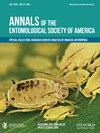Arthropod communities associated with gall-inducing Aciurina bigeloviae and Aciurina trixa (Diptera: Tephritidae) in New Mexico
IF 1.8
3区 农林科学
Q1 ENTOMOLOGY
引用次数: 0
Abstract
Insect-induced galls are novel structures that serve as habitat to whole communities of associate arthropods that include predators, parasitoids, and inquilines. Galling insects are generally under-described, but their associate communities, which can include many specialist organisms, are virtually unknown, particularly in the southwest United States. Aciurina bigeloviae (Cockerell 1890) and Aciurina trixa Curran 1932 (Diptera: Tephritidae) are unusually common and abundant galling flies in New Mexico. The 2 species are sister and occur in sympatric areas but have distinct gall morphologies. We reared all arthropods from 3,800 galls from 14 sites in the northern and central regions of the state and as a result characterized the complete communities of both species, including barcode sequences and eclosion phenology. We also investigate interactions of A. trixa galls with the abundant inquiline weevil Anthonomus cycliferus Fall 1913 (Coleoptera: Circulionidae) and find no measurable effect of inquiline abundance on the size of the emerged adult fly or gall. The total species count is 24 and includes 6 guilds; both A. bigeloviae and A. trixa communities are richer and more complex than other documented Tephritidae–Asteraceae galling systems. This study highlights the potential of galling insects as ecosystem engineers to maintain large, rich, and multi-trophic communities.新墨西哥州与引胆虫 Aciurina bigeloviae 和 Aciurina trixa(双翅目:Tephritidae)相关的节肢动物群落
昆虫诱发的虫瘿是一种新型结构,可作为包括捕食者、寄生虫和绻虫在内的整个节肢动物群落的栖息地。一般来说,对虫瘿的描述较少,但其伴生群落(可能包括许多专门生物)却几乎不为人知,尤其是在美国西南部。Aciurina bigeloviae(Cockerell,1890 年)和 Aciurina trixa Curran,1932 年(双翅目:栉蝇科)是新墨西哥州异常常见和大量的瘿蚊。这两个物种是姊妹物种,出现在同域,但有不同的虫瘿形态。我们从该州北部和中部地区的 14 个地点的 3,800 个虫瘿中饲养了所有节肢动物,从而确定了这两个物种的完整群落特征,包括条形码序列和羽化物候学。我们还研究了 A. trixa虫瘿与丰富的inquiline象鼻虫Anthonomus cycliferus Fall 1913(鞘翅目:Circulionidae)之间的相互作用,发现inquiline的丰富程度对出现的成蝇或虫瘿的大小没有可测量的影响。总物种数为 24 种,包括 6 个类群;与其他有文献记载的 Tephritidae-Asteraceae 类瘿蚊系统相比,A. bigeloviae 和 A. trixa 群落更为丰富和复杂。这项研究凸显了取胆昆虫作为生态系统工程师在维持大型、丰富和多营养群落方面的潜力。
本文章由计算机程序翻译,如有差异,请以英文原文为准。
求助全文
约1分钟内获得全文
求助全文
来源期刊
CiteScore
4.90
自引率
0.00%
发文量
25
审稿时长
6-12 weeks
期刊介绍:
The Annals of the Entomological Society of America exists to stimulate interdisciplinary dialogue across the entomological disciplines and to advance cooperative interaction among diverse groups of entomologists. It seeks to attract and publish cutting-edge research, reviews, collections of articles on a common topic of broad interest, and discussion of topics with national or international importance. We especially welcome articles covering developing areas of research, controversial issues or debate, and topics of importance to society. Manuscripts that are primarily reports of new species, methodology, pest management, or the biology of single species generally will be referred to other journals of the ESA. The most important criteria for acceptance are quality of work and breadth of interest to the readership.

 求助内容:
求助内容: 应助结果提醒方式:
应助结果提醒方式:


